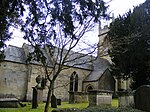Church of St James, Southstoke

The Church of St James is an Anglican parish church in Southstoke, Somerset, England. It was built in the 12th century and has been designated as a Grade II* listed building. Dedicated to James, son of Zebedee, known in England as St James the Great, the original 12th-century building was altered in the 15th century. Further restoration was undertaken in the 1840s and 1850s when the chancel and south aisle were rebuilt. However, the north door is Norman. Pevsner says of it Low Perp. w. tower. Nave with Norman n. doorway. One order of columns, both patterned with a lozenge design, but the r. one in addition with two alternating smaller motifs in the lozenges. Lintel with low-pitched top, chip-carved. Tympanum with a trellis pattern of roll-mouldings. Arch with rosettes, three-dimensional zigzag and a kind of flat plait. S. aisle and chancel 1845 and c. 1850. Pulpit – stone, polygonal, probably Perp. Pevsner also noted in the 1950s that the church plate included an Elizabethan chalice and a paten by Thomas Parr marked for the year 1700.The parish is part of the benefice of Combe Down with Monkton Combe and South Stoke within the archdeaconry of Bath.
Excerpt from the Wikipedia article Church of St James, Southstoke (License: CC BY-SA 3.0, Authors, Images).Church of St James, Southstoke
Old School Hill,
Geographical coordinates (GPS) Address External links Nearby Places Show on map
Geographical coordinates (GPS)
| Latitude | Longitude |
|---|---|
| N 51.349722222222 ° | E -2.3652777777778 ° |
Address
St. James the Great
Old School Hill
BA2 7DX
England, United Kingdom
Open on Google Maps










